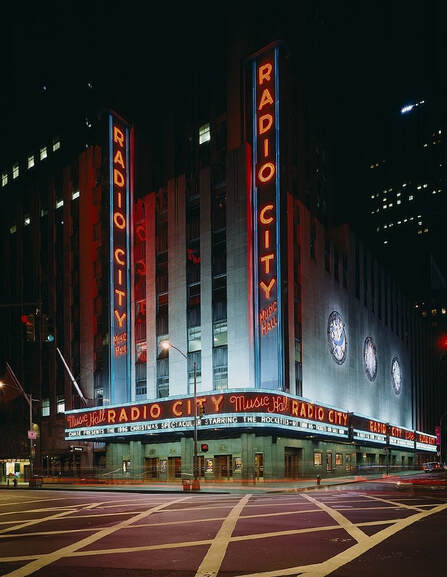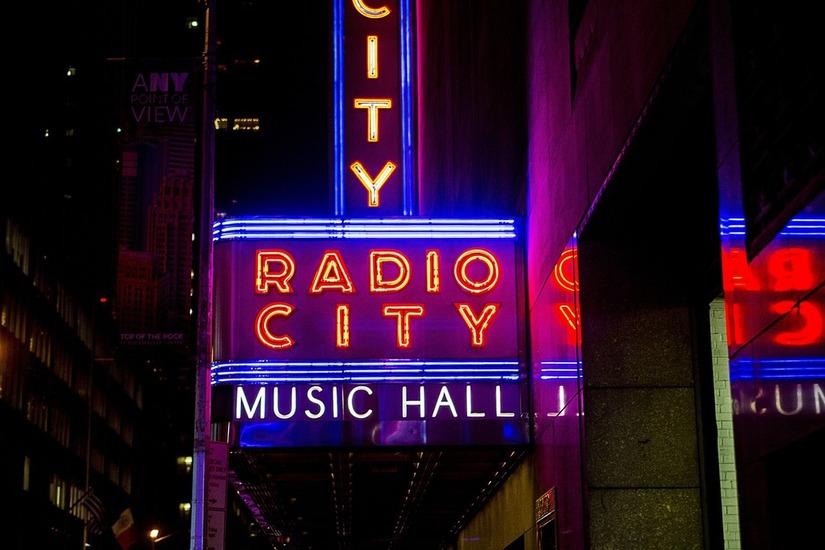|
On June 7, 2020, Radio City Music Hall in New York will host the 74th annual Tony Awards, honoring Broadway’s best. This year will be the 20th time the Tonys have been presented at Radio City. Radio City is one of the world’s most exciting and glamourous venues for performing arts. Events hosted there include vaudeville, movies, musical concerts, awards shows, and special programs of all kinds. As a result, it has become a beloved icon of American life, and a landmark site for visitors to New York. Here are nine of the most interesting facts you may not know about it: 1. It opened during the Great Depression.Radio City Music Hall opened on a rainy night in New York City on December 27, 1932. That a new theater and entertainment venue of its size would open in the depths of the Great Depression testifies to the longing of people, even in discouraging or desperate circumstances, to find comfort and encouragement in the power of high-quality music and performance. The venue was specifically designed to be a kind of people’s entertainment palace, a place that could bring beauty into everyday lives at an affordable admission price. 2. It has hosted over 300 million visitors since its opening.Opening night saw thousands of people waiting to enter the stunning new Art Deco building. In the almost 90 years since then, some 300 million visitors have enjoyed great performances on its stage. Radio City continues to reign as the world’s largest indoor theater, and one of the most visually magnificent. 3. It was built by John D. Rockefeller.It was John D. Rockefeller who decided to construct Radio City Music Hall. Rockefeller’s idea was to make it one of the cornerstones of his nascent entertainment complex at Rockefeller Center, located in an area he was in the process of renovating from its former rundown state. Rockefeller had leased the Midtown Manhattan property from Columbia University, planning to pursue a collaboration to build a new Metropolitan Opera House. But disagreements over planning—and the financial crash of the Great Depression—killed the project. Rockefeller decided to cut his losses and construct something the world had never before seen. He wanted to give New York City a large-scale entertainment complex, one so spectacular that it would attract commercial tenants and turn a profit even in the most difficult economic climate, when vacant properties were to be found available all over the city. 4. It was part of a partnership between Rockefeller, RCA, and Rothafel. Rockefeller teamed up with RCA, the Radio Corporation of America. RCA owned both the National Broadcasting Company (NBC) and RKO Pictures, whose movies were wildly popular across the nation. Rockefeller and RCA were joined by S. L. “Roxy” Rothafel, a legend in the theater world. “Roxy” oversaw productions that blended movies, vaudeville, and show-stopping design. His industry savvy had brought numerous financially strapped theaters back to life. This team of three then built Radio City Music Hall as the first venue within Rockefeller’s new complex. David Sarnoff, who headed RCA, was the one who gave it the name “Radio City.” 5. It was constructed in the Art Deco style.  Architect Edward Durell Stone was responsible for the imposing Art Deco exterior. However, it was the building’s interior that captivated audiences, both then and now. Designer Donald Deskey, who at the time was relatively unknown, provided the interior decor. The unlikely but inspired choice of Deskey resulted in the stunning entertainment palace we know today. On that opening night in 1932, Deskey’s work thrilled audiences, particularly in contrast to the lackluster show that evening. One critic wrote that the building itself was so magnificent that it did not even require performers. Deskey’s Art Deco esthetic choices focused on bringing clean lines, structural ornamentation, and a European Modernist sense to the design. Attendees first passed inside the building’s elegant lobby, then filed into the Grand Foyer. They could also enjoy eight distinct lounges with smoking areas. Each of these was created with a specific theme referring to another world culture. The entire building was, in fact, a celebration of humanity’s creativity in multiple fields: the arts, science, and industry. Art was a focal point of the overall design. Deskey worked with expert technicians and craftspeople to fill the building with distinctive wall decor, draperies, carpets, sculpture, and murals. He also employed 20th-century innovations in technology in the form of industrial materials such as aluminum and Bakelite, which for seamlessly integrated with stone- and woodwork, gold foil, and marble. Design enthusiasts continue to thrill to Radio City’s interior tactile richness, the variations in tone and color, and the vast interior spaces filled with sweeping, intricately lit arches that evoke the feeling of a sunset overhead. 6. It was constructed with the audience in mind. Radio City’s grandeur covers a lot of space. Its auditorium stretches 160 feet from the stage to the rear. Its ceiling soars more than 80 feet high, and its marquee spans an entire city block. There’s not a bad seat in the house, thanks to Deskey and his design team. A series of shallowly-constructed mezzanines are arranged in such a way that they don’t obstruct the orchestra section below them. Additionally, no columns block the ability to see the stage. The famous “Mighty Wurlitzer” organ was custom-built for Radio City’s theater. It has so many pipes—ranging in size from only a few inches to some 32 feet long—that it takes 11 rooms to contain its many sections. 7. Its stage is state-of-the-art.For performers and audiences alike, one of the central marvels of Radio City is its ingenious and technologically-advanced set of three hydraulically-powered stage risers. Radio City’s stage has won praise from theater experts and is still considered one of the most advanced and best-fitted-out stage spaces in the world. An additional elevator-riser allows technicians to shift the whole orchestra section up or down. A turntable provides the flexibility of making quick scene changes while supporting numerous possibilities for special effects like fog, rain, clouds, and spraying fountains. 8. It has premiered hundreds of movies over the years.Within two weeks of its opening night, Radio City hosted its first feature film, The Bitter Tea of General Yen, directed by Frank Capra and starring Barbara Stanwyck. It wasn’t long until a premiere at Radio City was the best way to ensure a movie’s success across the nation. Over the succeeding decades, some 700 movies have debuted at Radio City. These include King Kong in 1933, National Velvet (starring Elizabeth Taylor) in 1944, White Christmas in 1954, Breakfast at Tiffany’s in 1961, and Disney’s original Lion King in 1994. In 1962, To Kill a Mockingbird also premiered at Radio City, the same theater where the film’s star, Gregory Peck, had ushered as a young aspiring actor. 9. It is has been home to the Rockettes since its opening.Then there are the Rockettes. Previously known, among other names, as the Missouri Rockets, the all-female precision-dancing, super-high-kicking troupe got its start in the 1920s. The group landed in New York after a nationwide tour just as Radio City was preparing to open.
Discovered by none other than “Roxy” Rothafel, the Rockettes opened the first evening’s performance at Radio City Music Hall, and have been its most iconic performers ever since. In the late 1970s, when financial problems almost forced its closing, Radio City was buoyed back up on a wave of nationwide support led, in part, by the Rockettes. Although in the segregated 1930s, the Rockettes’ line-up was all-white, today’s Rockettes are moving toward embracing the full range of American diversity and talent. Most recently, the 2019 Christmas Spectacular show saw several new dancers of color joining the team, as well as a “differently-abled” dancer. Comments are closed.
|
Photo used under Creative Commons from Marina K Caprara

 RSS Feed
RSS Feed
